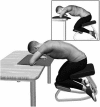Muscle Activity Adaptations to Spinal Tissue Creep in the Presence of Muscle Fatigue
- PMID: 26866911
- PMCID: PMC4750977
- DOI: 10.1371/journal.pone.0149076
Muscle Activity Adaptations to Spinal Tissue Creep in the Presence of Muscle Fatigue
Abstract
Aim: The aim of this study was to identify adaptations in muscle activity distribution to spinal tissue creep in presence of muscle fatigue.
Methods: Twenty-three healthy participants performed a fatigue task before and after 30 minutes of passive spinal tissue deformation in flexion. Right and left erector spinae activity was recorded using large-arrays surface electromyography (EMG). To characterize muscle activity distribution, dispersion was used. During the fatigue task, EMG amplitude root mean square (RMS), median frequency and dispersion in x- and y-axis were compared before and after spinal creep.
Results: Important fatigue-related changes in EMG median frequency were observed during muscle fatigue. Median frequency values showed a significant main creep effect, with lower median frequency values on the left side under the creep condition (p≤0.0001). A significant main creep effect on RMS values was also observed as RMS values were higher after creep deformation on the right side (p = 0.014); a similar tendency, although not significant, was observed on the left side (p = 0.06). A significant creep effects for x-axis dispersion values was observed, with higher dispersion values following the deformation protocol on the left side (p≤0.001). Regarding y-axis dispersion values, a significant creep x fatigue interaction effect was observed on the left side (p = 0.016); a similar tendency, although not significant, was observed on the right side (p = 0.08).
Conclusion: Combined muscle fatigue and creep deformation of spinal tissues led to changes in muscle activity amplitude, frequency domain and distribution.
Conflict of interest statement
Figures





Similar articles
-
Is activation of the back muscles impaired by creep or muscle fatigue?Spine (Phila Pa 1976). 2010 Mar 1;35(5):517-25. doi: 10.1097/BRS.0b013e3181b967ea. Spine (Phila Pa 1976). 2010. PMID: 20147877
-
Creep and fatigue development in the low back in static flexion.Spine (Phila Pa 1976). 2009 Aug 1;34(17):1873-8. doi: 10.1097/BRS.0b013e3181aa6a55. Spine (Phila Pa 1976). 2009. PMID: 19644340
-
Trunk proprioception adaptations to creep deformation.Eur J Appl Physiol. 2018 Jan;118(1):133-142. doi: 10.1007/s00421-017-3754-2. Epub 2017 Nov 8. Eur J Appl Physiol. 2018. PMID: 29116380
-
Effects of Muscle Fatigue, Creep, and Musculoskeletal Pain on Neuromuscular Responses to Unexpected Perturbation of the Trunk: A Systematic Review.Front Hum Neurosci. 2017 Jan 4;10:667. doi: 10.3389/fnhum.2016.00667. eCollection 2016. Front Hum Neurosci. 2017. PMID: 28101013 Free PMC article. Review.
-
The assessment of back muscle capacity using intermittent static contractions. Part I - Validity and reliability of electromyographic indices of fatigue.J Electromyogr Kinesiol. 2008 Dec;18(6):1006-19. doi: 10.1016/j.jelekin.2007.03.012. Epub 2007 Jul 20. J Electromyogr Kinesiol. 2008. PMID: 17643316 Review.
Cited by
-
Do Lumbar Paravertebral Muscle Properties Show Changes in Mothers with Moderate-Severity Low Back Pain Following a Cesarean Birth? A Case-Control Study.J Clin Med. 2025 Jan 23;14(3):719. doi: 10.3390/jcm14030719. J Clin Med. 2025. PMID: 39941389 Free PMC article.
-
Measuring Muscle Activity in the Trunk, Pelvis, and Lower Limb Which Are Used to Maintain Standing Posture in Patients With Adult Spinal Deformity, With Focus on Muscles that Contract in the Compensatory Status.Global Spine J. 2023 Oct;13(8):2245-2254. doi: 10.1177/21925682221079257. Epub 2022 Feb 22. Global Spine J. 2023. PMID: 35192405 Free PMC article.
-
Neck Pain: Do We Know Enough About the Sensorimotor Control System?Front Comput Neurosci. 2022 Jul 15;16:946514. doi: 10.3389/fncom.2022.946514. eCollection 2022. Front Comput Neurosci. 2022. PMID: 35910451 Free PMC article. Review.
-
The influence of long-term shoulder loading on sagittal spino-pelvic morphology: a population-based retrospective study of Chinese farmers from radiology.J Orthop Surg Res. 2020 May 29;15(1):196. doi: 10.1186/s13018-020-01698-3. J Orthop Surg Res. 2020. PMID: 32471454 Free PMC article.
-
Changes in Lumbopelvic Movement and Muscle Recruitment Associated with Prolonged Deep Squatting: A Pilot Study.Int J Environ Res Public Health. 2018 May 16;15(5):1001. doi: 10.3390/ijerph15051001. Int J Environ Res Public Health. 2018. PMID: 29772741 Free PMC article.
References
-
- Panjabi MM. The stabilizing system of the spine. Part I. Function, dysfunction, adaptation, and enhancement. Journal of spinal disorders. 1992;5(4):383–9; discussion 97. Epub 1992/12/01. . - PubMed
-
- Callaghan JP, Gunning JL, McGill SM. The relationship between lumbar spine load and muscle activity during extensor exercises. Physical therapy. 1998;78(1):8–18. . - PubMed
-
- Granata KP, Marras WS. Cost-benefit of muscle cocontraction in protecting against spinal instability. Spine. 2000;25(11):1398–404. . - PubMed
Publication types
MeSH terms
LinkOut - more resources
Full Text Sources
Other Literature Sources

